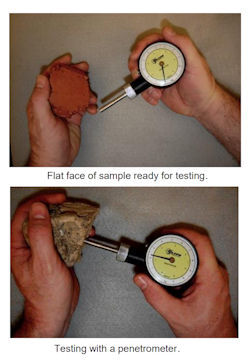Methods for Evaluating Soil Type
Site Soil Analysis
An analysis of conditions around the site is conducted by observing soil adjacent to the site and the soil being excavated. If the soil remains in clumps, it is cohesive; if it appears to be coarse-grained sand or gravel, it is considered granular. The evaluator also checks for any signs of vibration.
During the analysis, the evaluator should check for crack-line openings along the failure zone that would indicate tension cracks, look for existing utilities that indicate that the soil has previously been disturbed, and observe the open side of the excavation for indications of layered geologic structuring.
The evaluator should also look for signs of bulging, boiling, or sluffing, as well as for signs of surface water seeping from the sides of the excavation or from the water table. The area adjacent to the excavation should be checked for signs of foundations or other intrusions into the failure zone, and the evaluator should check for surcharging and the spoil distance from the edge of the excavation.
Test Methods
When performing a soil test, it's important to choose a good soil sample. Soil samples should be typical of the surrounding soil in the excavation, and additional samples should be taken as the excavation gets deeper. While the excavation wall is one place to take samples, OSHA recommends taking a large clump from the excavated pile, as long as the soil in the pile is fresh and hasn't been compacted. Test results can change as the soil dries up, so for the best results, samples should be taken and tested as soon as practical.
Four Basic Methods for Evaluating Soil Types
Plasticity or Wet Thread Test
The plasticity (cohesiveness) test, which is sometimes called the pencil test, is used to determine if the soil is cohesive.
- This test is performed by rolling a moist soil sample into a thread that's one-eighth of an inch (3 mm) thick and two inches (5 cm) long, resembling a short, slim pencil.
- If the sample can be held at one end without breaking, it is cohesive.
- Any soil that is not cohesive is automatically classified as Type C, although some Type C soils are cohesive.
Thumb Penetration Test
The thumb penetration test is used to quickly estimate the compressive strength of a cohesive soil sample. To perform the thumb penetration test, simply press the end of your thumb into a fresh clump of soil.
- If the soil sample is Type A, your thumb will only make an indentation in the soil with great effort.
- If the soil sample is Type B, your thumb will sink into the soil up to the end of your thumbnail.
- If the soil sample is Type C, your thumb will sink all the way into the soil clump.
Your results for this test will probably be somewhere in between these results.
Dry Strength Test
This test is usually conducted on a small sample of dried soil 1/2 inch think and 1 1/2 in diameter. After the sample is dry, try to break it using the thumbs and forefingers of both hands.
- Dry soil that crumbles freely or with moderate pressure into individual grains is granular.
- Dry soil that falls into clumps that subsequently break into smaller clumps (and the smaller clumps can be broken only with difficulty) is probably clay in combination with gravel, sand or silt.
- If the soil breaks into clumps that do not break into smaller clumps (and the soil can be broken only with difficulty), the soil is considered non-fissured unless there is visual indication of fissuring.
Pocket Penetrometer Test
For a more numeric measurement, the pocket penetrometer test can be used. A soil's compressive strength can be given a numeric value by using the pocket penetrometer test. There can be some variability (+ 20-40%) in these results, so it's a good idea to run this test on a few soil samples from the same part of the excavation, just to make sure your results are consistent.
- A pocket penetrometer works much like a tire pressure gauge.
- A thin, metal piston is pushed into a soil sample, and the penetrometer records the compressive strength of the soil.
- Be sure that the scale indicator is inserted into the penetrometer body until only the "zero" mark is showing.
- To conduct the test, push the piston into the soil until it reaches the engraved line. Then, simply take the reading from the scale indicator.
- It's important to recognize that a penetrometer may give false results if the soil contains rocks or pebbles, which won't compress.
Knowledge Check Choose the best answer for the question.
2-6. OSHA recommends taking a large clump from the excavated pile, as long as the soil in the pile _____.
You forgot to answer the question!

